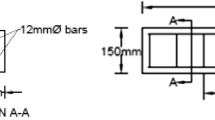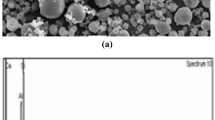Abstract
Alkali activated fly ash concrete (AAFAC) is an alternative form of concrete that uses coal fly ash as a 100 % replacement for ordinary portland cement (OPC). In this paper structural testing of nine steel reinforced AAFAC beams is explored. The test matrix included three over-reinforced, three under-reinforced, and three shear critical AAFAC beam samples, all tested in four point monotonic bending. For control purposes, an identical set of OPC concrete (OPCC) beams was fabricated and tested under identical conditions. Data collection during testing included load, deflection, top and side fiber concrete strains, and crack width. Test results show that AAFAC beams have very similar behavior to companion OPCC beams. This applies to load induced crack pattern, crack width magnitude, neutral axis location, flexural stiffness, and ultimate flexural and ultimate shear strengths. The research concludes that AAFAC flexural members can be designed using existing ACI 318-08 methods developed for OPCC, and that this applies to both the service and ultimate limit states.








Similar content being viewed by others
References
ACAA (2009) Coal combustion products production & use statistics, American Coal Ash Association, Washington http://acaa.affiniscape.com/displaycommon.cfm?an=1&subarticlenbr=3. Accessed 04 Jan 2012
ACI (2002 and 2008) Building code requirements for structural concrete (ACI 318-02 and ACI 318-08) and commentary, American Concrete Inst., Farmington Hills
ASTM International (2008) Standard specifications for coal fly ash and raw or calcined pozzolan for use in concrete, ASTM Designation C 618-08a, ASTM International, West Conshohocken
Cross D, Stephens J, Vollmer J (2005) Structural applications of 100 percent fly ash concrete, Proceedings from the world of coal ash (WOCA), 11–15 April 2005, Lexington http://www.flyash.info/2005/131cro.pdf. Accessed 04 Jan 2012
Berry M, Cross D, Stephens J (2009) Changing the environment: an alternative “Green” concrete produced without Portland cement, Proceedings from the world of coal ash (WOCA), 04–07 May 2009, Lexington http://www.flyash.info/2009/130-berry2009.pdf. Accessed 04 Jan 2012
Fernandez-Jiménez A, Palomo A (2005) Composition and microstructure of alkali activated fly ash binder: effect of the activator, Cem Concr Res, 35.10 (Oct 2005): 1984–1992. Sciencedirect, Web. 12 Sept. 2010
Fernandez-Jiménez A, Palomo A, Lopez-Hombrados C (2006) Engineering properties of alkali-activated fly ash concrete. ACI Material J 103(2):106–112
Gergely P, Lutz LA (1968) Maximum crack width in reinforced concrete flexural members, SP-20, American Concrete Institute, Detroit, pp 1–17
FHWA (2011) Blended and performance cements, Technical Brief No. FHWA-HIF-11-025, Federal Highway Administration, Washington
Nilson AH, Darwin D, Dolan C (2004) Design of concrete structures, 13th edn. McGraw Hill, New York
Palomo A, Grutzeck, Blanco MT (1998) Alkali-activated fly ashes. A cement for the future. Cement Concr Res. 29.8 (Aug. 1998): 1323–1329. Sciencedirect, Web. 12 Sept. 2010
Popovics S (1973) A numerical approach to the complete stress-strain curve for concrete. Cem Concr Res 3:583–599
Sarker PK (2009) Analysis of geopolymer concrete columns. J Material Sci 42:715–724
Sumajouw DMJ, Hardjito D, Wallah S, Rangan BV (2005) Behavior of geopolymer concrete columns under equal load eccentricities, American Concrete Institute SP-228-38, Farmington Hills, pp. 577–594
Standards Australia (AS 2005) Concrete structures, Draft Australian Standard, Committee-BD-002-Concrete Structures, Standards Australia
Sumajouw MDJ, Rangan BV (2006). Low calcium fly ash based geopolymer concrete: reinforced beams and columns, Research Report GC-3, Faculty of Engineering, Curtin University of Technology, Perth
Sumajouw DMJ, Hardjito D, Wallah S, Rangan BV (2007) Fly ash-based geopolymer concrete: study of slender reinforced columns. J Material Sci 42:3124–3130
Thorenfeldt E, Tomaszewicz A, Jensen JJ (1987) Mechanical properties of high strength concrete and applications in design, Proceedings of the symposium on utilization of high strength concrete, Tapir, pp 149–159
Acknowledgments
The authors wish to thank the National Science Foundation under Award Number 0923818 for providing financial support for this project, and the Office of Research and Sponsored Projects at Villanova University for providing graduate student tuition. Finally the collaboration and in-kind support provided by Oldcastle Precast of Telford, PA, USA is acknowledged and greatly appreciated.
Author information
Authors and Affiliations
Corresponding author
Additional information
This is a two-part research publication describing an experimental program involving fabrication and structural testing of full scale steel reinforced AAFAC beams. Part 1 of the article series presents the AAFAC mixture design, batching and concrete placement, methods of curing at elevated temperature, time–temperature data measured during curing, and hardened material properties of the AAFAC including compression strength, elastic modulus, and stress–strain behavior. In Part 2 of the article series the structural testing program is described, methods of analysis presented, and four point bending test results related to neutral axis location, strength, stiffness, failure mode, and crack width discussed.
Rights and permissions
About this article
Cite this article
Yost, J.R., Radlińska, A., Ernst, S. et al. Structural behavior of alkali activated fly ash concrete. Part 2: structural testing and experimental findings. Mater Struct 46, 449–462 (2013). https://doi.org/10.1617/s11527-012-9985-0
Received:
Accepted:
Published:
Issue Date:
DOI: https://doi.org/10.1617/s11527-012-9985-0




